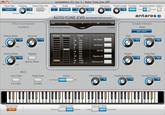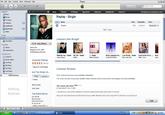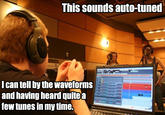Auto-Tune
Featured Episode
About
Auto-Tune is an automated pitch-correction and audio-processing software developed by Antares Audio Technologies in 1997. While the technology has been silently at work behind various hits for over a decade, it was introduced to larger audiences after the breakout of rapper, singer and producer T-Pain, who experimented heavily with auto-tune effect in his albums. Since its mass popularization through pop music hits in 2007, online videos of all genres have been treated with the software for humorous effect.
Origin
At first, Auto-Tune was primarily used as a subtle way to cover the mistakes of a vocalist off their game; smoothly sliding the pitch to the correct note. Then in 1998, Cher's single Believe[1] came out. People had heard vocoders in the past, but this was different. Cher's voice snapped from one pitch to the next, as if her vocal chords had been quantized, leading some people to ask "what is that effect?" It was Auto-Tune, used excessively, to distort the tonal features of the voice.

With the expense of the Antares Auto-Tune plugin[6] and the relative lack of social networking sites at the time, Auto-Tune remained something of a trade secret among many record producers who simply wanted to save time while working in the studio. But as online social communities, user-generated content, video tutorials, and open-source software proliferated in recent years, so did the availability, usage, and experimentation of Auto-Tune.
Online Spread
In 2005, rapper T-Pain made his debut with the album Rappa Ternt Sanga[2]. The album used Auto-Tune heavily on every track, such as his first single "Sprung"[3] giving T-Pain his signature sound. Many would call it a gimmick and many would be right. But regardless, T-Pain's followup 2007 album Epiphany debuted at #1, bringing the "always on Auto-Tune" artist to the masses.
2007 also saw the release of first-person puzzle-platform video game Portal, featuring the song Still Alive written by Jonathan Coulton and sung by Ellen McLain as GLaDOS. The popularity of T-Pain, Portal and similar use of the effect by other popular artists such as Rhianna, Diddy and Kanye West all contributed to its ubiquitous presence throughout the year.
On February 9th, 2009, The Lonely Island and T-Pain's video I'm on a Boat was released. The video would attract over 21 million views.
Notable Examples
The majority of "T-Pain effect" tutorial videos are hosted on YouTube. The larger group conversation started between aspiring audio techs, but due to the versatility of the “just add Auto-Tune” formula, the conversation spread from serious projects to silly ones.
Crying T-Pain Baby
Auto-Tune the News
SNL Digital Sketch: I'm on a Boat
Slap Chop (Rap & Autotuned)
Winston Churchill's Speech Backed By Band from the Future:
The Anti-Autotune Movement
Controversy soon arose surrounding Auto-Tune, involving vocalists who use auto-tune, and those who feel that Auto-Tune is a ripoff. On June 5th, 2009, Jay-Z's D.O.A. (Death of Autotune) was released online. Auto-Tune had obviously become saturated in both mainstream media and user generated content, and the anti-Auto-Tune movement now has a spokesman:
On July 8th, 2009, legendary rapper KRS-ONE made his own Anti Auto-Tune video featuring underground rapper Buckshot:
Oscars 2011 Ceremony: Autotune Remix of Nominated Films
During the Oscars 2011 ceremony, hosts James Franco and Anne Hathway presented a short musical tribute featuring pivotal scenes from this year's Academy Awards-nominated films, including a dialogue scene between Ron & Hermione from "Harry Potter and the Deathly Hallows: Part 1," a Woody and the gang moment from "Toy Story 3," Justin Timberlake's diner talk scene from "The Social Network" and even Edward's sneering line "doesn't he own a shirt?" aimed at his romantic rival Jacob from "Twilight Saga: Eclipse." Several tweets[4] posted by the Gregory Brothers shortly before and after their performance further confirmed that Autotune trio was behind the surprise project.
T-Pain vs. Antares Software
On July 29th, 2011, AllHipHop.com[5] reported that T-Pain has filed suit against Antares Software for continuing to use his image and likeness in advertisements and marketing for Auto-Tune, after their formal endorsement deal expired in June 2011.

According to a complaint filed in U.S. District Court in California on July 25th, T-Pain is seeking $1 million dollars in damages as he will be soon promoting his own brand of audio technologies like "I am T-Pain Mic" and "The T-Pain Effect," a vocal manipulator developed in partnership with another software company called Izotope. In addition to $1 million dollars, T-Pain is also looking to prohibit the Auto-Tune developers from using his name image, likeness, photograph, voice or anything else connecting him to Antares' competing products.
T-Pain's Products



Search Interest
According to Google Insights, 2007 marked the beginning of the public's curiosity about Auto-Tune.
External References
[1] YouTube- Cher – Believe
[2] YouTube – T-Pain – I'm Sprung
[3] MTV – Oscars Auto-Tune Montage
[4] Twitter – @autotunethenews
[5] AllHipHop – Legal Warfare Breaks Out Between Producer T-Pain and Autotune Maker
[6] Antares – Antares Audio Technologies



















Top Comments
rapturjesus
Jul 29, 2011 at 01:00PM EDT
Slutty Sam
May 17, 2013 at 10:02PM EDT